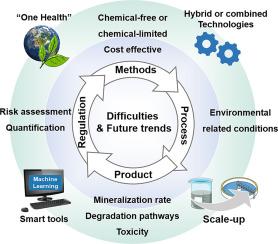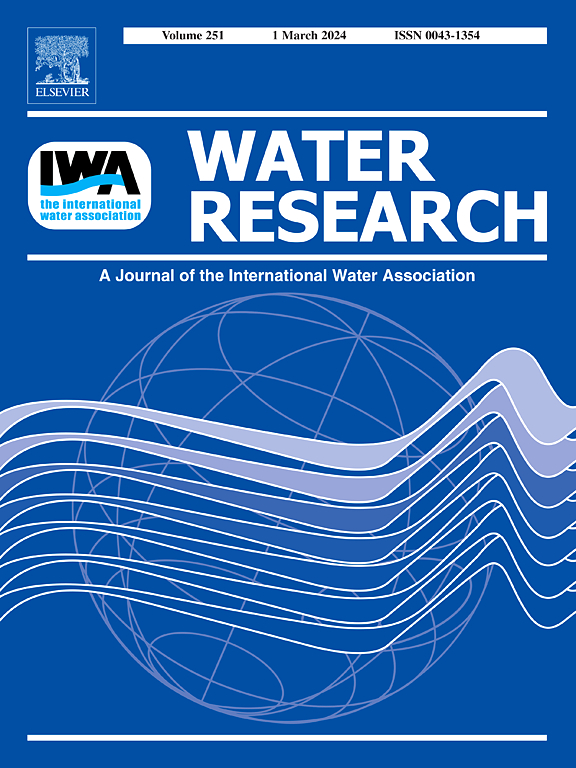How far do we still need to go with antibiotics in aquatic environments? Antibiotic occurrence, chemical-free or chemical-limited strategies, key challenges, and future perspectives
IF 11.4
1区 环境科学与生态学
Q1 ENGINEERING, ENVIRONMENTAL
引用次数: 0
Abstract
Global consumption and progressive migration of antibiotics through aquatic systems have contributed to their rapid spread, posing significant threats to environmental and human health, and antibiotics have been recognized as emerging pollutants. Hence, extensive approaches have been proposed for antibiotic treatment in water, yielding great achievements. This review systematically summarized current knowledge from contamination characteristics to treatment strategies. First, the prevalence and characteristics of antibiotics in aquatic environments were discussed and chemical-free or chemical-limited strategies were subsequently reviewed, i.e. adsorption, membrane separation, electrochemistry, and photocatalysis. Thereafter, gaps were identified between conditions for treatment in aquatic environments and lab-scale experiments, emphasizing that simulated antibiotic concentrations in laboratory studies were often hundreds of times higher than those found in natural settings and lack consideration of complex water matrices. Additionally, concerns regarding health risks arose due to unexpectedly low mineralization rates. For future advancements, hybrid or combined technologies were recommended, along with the integration of smart tools such as machine learning for deeper insights into degradation processes and cross-risk assessments. This review offers valuable guidance for establishing effective strategies to control antibiotics in aquatic environments.


我们在水生环境中使用抗生素还需要走多远?抗生素的出现,无化学品或化学品限制的策略,主要挑战,和未来的前景
抗生素的全球消费和通过水生系统的逐步迁移促成了它们的迅速传播,对环境和人类健康构成重大威胁,抗生素已被认为是新出现的污染物。因此,人们提出了广泛的方法来处理水中的抗生素,并取得了很大的成就。这篇综述系统地总结了目前从污染特征到处理策略的知识。首先,讨论了抗生素在水生环境中的流行和特征,并随后回顾了无化学或限制化学的策略,即吸附、膜分离、电化学和光催化。此后,确定了水生环境处理条件与实验室规模实验之间的差距,强调实验室研究中的模拟抗生素浓度通常比自然环境中的抗生素浓度高数百倍,并且缺乏对复杂水基质的考虑。此外,由于矿化率出乎意料地低,人们对健康风险感到担忧。对于未来的发展,建议采用混合或组合技术,同时集成智能工具,如机器学习,以更深入地了解降解过程和交叉风险评估。本文综述为制定有效的水生环境抗生素控制策略提供了有价值的指导。
本文章由计算机程序翻译,如有差异,请以英文原文为准。
求助全文
约1分钟内获得全文
求助全文
来源期刊

Water Research
环境科学-工程:环境
CiteScore
20.80
自引率
9.40%
发文量
1307
审稿时长
38 days
期刊介绍:
Water Research, along with its open access companion journal Water Research X, serves as a platform for publishing original research papers covering various aspects of the science and technology related to the anthropogenic water cycle, water quality, and its management worldwide. The audience targeted by the journal comprises biologists, chemical engineers, chemists, civil engineers, environmental engineers, limnologists, and microbiologists. The scope of the journal include:
•Treatment processes for water and wastewaters (municipal, agricultural, industrial, and on-site treatment), including resource recovery and residuals management;
•Urban hydrology including sewer systems, stormwater management, and green infrastructure;
•Drinking water treatment and distribution;
•Potable and non-potable water reuse;
•Sanitation, public health, and risk assessment;
•Anaerobic digestion, solid and hazardous waste management, including source characterization and the effects and control of leachates and gaseous emissions;
•Contaminants (chemical, microbial, anthropogenic particles such as nanoparticles or microplastics) and related water quality sensing, monitoring, fate, and assessment;
•Anthropogenic impacts on inland, tidal, coastal and urban waters, focusing on surface and ground waters, and point and non-point sources of pollution;
•Environmental restoration, linked to surface water, groundwater and groundwater remediation;
•Analysis of the interfaces between sediments and water, and between water and atmosphere, focusing specifically on anthropogenic impacts;
•Mathematical modelling, systems analysis, machine learning, and beneficial use of big data related to the anthropogenic water cycle;
•Socio-economic, policy, and regulations studies.
 求助内容:
求助内容: 应助结果提醒方式:
应助结果提醒方式:


